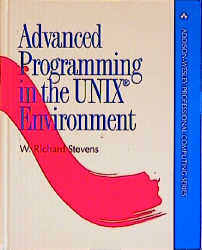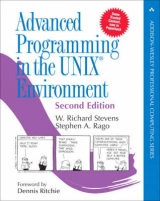
Advanced Programming in the UNIX Environment
Addison Wesley (Verlag)
978-0-201-56317-7 (ISBN)
- Titel erscheint in neuer Auflage
- Artikel merken
Bestselling UNIX author W. Richard Stevens offers application developers and system programmers his professional, experience-based guidance on using the system call interface with C. In the first half of the book, Stevens describes more than 200 system calls and functions with a brief example program following each description. Having provided the basics, Stevens moves on to chapter-long examples. The book is applicable to all major UNIX releases, especially System V Release 4-including Solaris 2-and 4.4 BSD, including 386 BSD.
We are deeply saddened to learn of the death of noted author W. Richard Stevens. His passing is obviously a tremendous loss for the technical community, but it is a personal one for us as well. Rich was both a gifted colleague and a valued friend who will be greatly missed. We extend our sympathies to his family. Obituary from the Arizona Daily Star: STEVENS, W. Richard, noted author of computer books died on September 1. He is best known for his "UNIX Network Programming" series (1990, 1998, 1999), "Advanced Programming in the UNIX Environment" (1992), and "TCP/IP Illustrated" series (1994, 1995, 1996). Richard was born in 1951 in Luanshya, Northern Rhodesia (now Zambia), where his father worked for the copper industry. The family moved to Salt Lake City, Hurley, New Mexico, Washington, DC and Phalaborwa, South Africa. Richard attended Fishburne Military School in Waynesboro, Virginia. He received a B.SC. in Aerospace Engineering from the University of Michigan in 1973, and an M.S. (1978) and Ph.D. (1982) in Systems Engineering from the University of Arizona. He moved to Tucson in 1975 and from then until 1982 he was employed at Kitt Peak National Observatory as a computer programmer. From 1982 until 1990 he was Vice President of Computing Services at Health Systems International in New Haven, CT, moving back to Tucson in 1990. Here he pursued his career as an author and consultant. He was also an avid pilot and a part-time flight instructor during the 1970's. He is survived by his loving wife of 20 years, Sally Hodges Stevens; three wonderful children, Bill, Ellen and David; sister, Claire Stevens of Las Vegas, NV; brother, Bob and wife Linda Stevens of Dallas, TX; nieces, Laura, Sarah, Collette, Christy; and nephew, Brad. He is predeceased by his parents, Royale J. Stevens (1915-1984); and Helen Patterson Stevens (1916-1997). Helen lived in Tucson from 1991-1997, and Royale lived here in the early 1930's attending Tucson High School while his father was treated for TB at the Desert Sanitorium (now TMC). The family asks that in lieu of flowers, donations be made in Richard's name to Habitat for Humanity, 2950 E. 22nd Street, Tucson, AZ 85713. A memorial service for Richard will be held at St. Phillip's in the Hills Episcopal Church on Tuesday, September 7th at 12:00 noon. Following the service there will be a reception in the Murphy Gallery of the Church. Please wear colorful clothing to the service; Richard loved colors. W. Richard Stevens was an acknowledged UNIX and networking expert and the highly-respected author of several books. He was also a sought-after instructor and consultant. 0201563177AB04062001
(Each chapter begins with an Introduction and concludes with a Summary.)
1. Introduction.
Logging In.
Files and Directories.
Input and Output.
Programs and Processes.
ANSI C Features.
Error Handling.
User Identification.
Signals.
Unix Time Values.
System Calls and Library Functions.
2. Unix Standardization and Implementations.
Unix Standardization.
ANSI C.
IEEE POSIX.
X/Open XPG3.
FIPS.
Unix Implementations.
System V Release 4.
4.3+BSD.
Relationship of Standards and Implementations.
Limits.
ANSI C Limits.
POSIX Limits.
XPG3 Limits.
sysconf, pathconf, and fpathconf Functions.
FIPS 151-1 Requirements.
Summary of Limits.
Indeterminate Run-Time Limits.
Feature Test Macros.
Primitive System Data Types.
Conflicts Between Standards.
3. File I/O.
File Descriptors.
open Function.
creat Function.
close Function.
lseek Function.
read Function.
write Function.
I/O Efficiency.
File Sharing.
Atomic Operations.
dup and dup2 Functions.
fcntl Function.
ioctl Function.
/dev/fd.
4. Files and Directories.
stat, fstat, and lstat Functions.
File Types.
Set-User-ID and Set-Group-ID.
File Access Permissions.
Ownership of New Files and Directories.
access Function.
umask Function.
chmod and fchmod Functions.
Sticky Bit.
chown, fchown, and lchown Functions.
File Size.
File Truncation.
Filesystems.
link, unlink, remove, and rename Functions.
Symbolic Links.
symlink and readlink Functions.
File Times.
utime Function.
mkdir and rmdir Functions.
Reading Directories.
chdir, fchdir, and getcwd Functions.
Special Device Files.
sync and fsync Functions.
Summary of File Access Permission Bits.
5. Standard I/O Library.
Streams and FILE Objects.
Standard Input, Standard Output, and Standard Error.
Buffering.
Opening a Stream.
Reading and Writing a Stream.
Line-at-a-Time I/O.
Standard I/O Efficiency.
Binary I/O.
Positioning a Stream.
Formatted I/O.
Implementation Details.
Temporary Files.
Alternatives to Standard I/O.
6. System Data Files and Information.
Password File.
Shadow Passwords.
Group File.
Supplementary Group IDs.
Other Data Files.
Login Accounting.
System Identification.
Time and Date Routines.
7. The Environment of a Unix Process.
main Function.
Process Termination.
Command-Line Arguments.
Environment List.
Memory Layout of a C Program.
Shared Libraries.
Memory Allocation.
Environment Variables.
setjmp and longjmp Functions.
getrlimit and setrlimit Functions.
8. Process Control.
Process Identifiers.
fork Function.
vfork Function.
exit Functions.
wait and waitpid Functions.
wait3 and wait4 Functions.
Race Conditions.
exec Functions.
Changing User IDs and Group IDs.
Interpreter Files.
system Function.
Process Accounting.
User Identification.
Process Times.
9. Process Relationships.
Terminal Logins.
Network Logins.
Process Groups.
Sessions.
Controlling Terminal.
tcgetpgrp and tcsetpgrp Functions.
Job Control.
Shell Execution of Programs.
Orphaned Process Groups.
4.3+BSD Implementation.
10. Signals.
Signal Concepts.
signal Function.
Unreliable Signals.
Interrupted System Calls.
Reentrant Functions.
SIGCLD Semantics.
Reliable Signal Terminology and Semantics.
kill and raise Functions.
alarm and pause Functions.
Signal Sets.
sigprocmask Function.
sigpending Function.
sigaction Function.
sigsetjmp and siglongjmp Functions.
sigsuspend Function.
abort Function.
system Function.
sleep Function.
Job-Control Signals.
Additional Features.
11. Terminal I/O.
Overview.
Special Input Characters.
Getting and Setting Terminal Attributes.
Terminal Option Flags.
stty Command.
Baud Rate Functions.
Line Control Functions.
Terminal Identification.
Canonical Mode.
Noncanonical Mode.
Terminal Window Size.
termcap, terminfo, and curses.
12. Advanced I/O
Nonblocking I/O.
Record Locking.
Streams.
I/O Multiplexing.
select Function.
poll Function.
Asynchronous I/O.
System V Release 4.
4.3+BSD.
readv and writev Functions.
readn and writen Functions.
Memory Mapped I/O.
13. Daemon Processes.
Daemon Characteristics.
Coding Rules.
Error Logging.
SVR4 Streams log Driver.
4.3+BSD syslog Facility.
Client-Server Model.
14. Interprocess Communication.
Pipes.
popen and pclose Functions.
Coprocesses.
FIFOs.
System V IPC.
Identifiers and Keys.
Permission Structure.
Configuration Limits.
Advantages and Disadvantages.
Message Queues.
Semaphores.
Shared Memory.
Client-Server Properties.
15. Advanced Interprocess Communication.
Stream Pipes.
Passing File Descriptors.
System V Release 4.
4.3BSD.
4.3+BSD.
An Open Server, Version 1.
Client-Server Connection Functions.
System V Release 4.
4.3+BSD.
An Open Server, Version 2.
16. A Database Library.
History.
The Library.
Implementation Overview.
Centralized or Decentralized?
Concurrency.
Source Code.
Performance.
17. Communicating with a PostScript Printer.
PostScript Communication Dynamics.
Printer Spooling.
Source.
Code.
18. A Modem Dialer.
History.
Program Design.
Data Files.
Server Design.
Server Source Code.
Client Design.
Client Source Code.
19. Pseudo Terminals.
Overview.
Opening Pseudo-Terminal Devices.
System V Release 4.
4.3+BSD.
pty_fork Function.
pty Program.
Using the pty Program.
Advanced Features.
Appendix A. Function Prototypes.
Appendix B. Miscellaneous Source Code.
Our Header File.
Standard Error Routines.
Appendix C. Solutions to Selected Exercises.
Bibliography.
Index. 0201563177T04062001
| Erscheint lt. Verlag | 6.7.1992 |
|---|---|
| Verlagsort | Boston |
| Sprache | englisch |
| Gewicht | 1790 g |
| Themenwelt | Informatik ► Betriebssysteme / Server ► Unix / Linux |
| ISBN-10 | 0-201-56317-7 / 0201563177 |
| ISBN-13 | 978-0-201-56317-7 / 9780201563177 |
| Zustand | Neuware |
| Haben Sie eine Frage zum Produkt? |
aus dem Bereich



